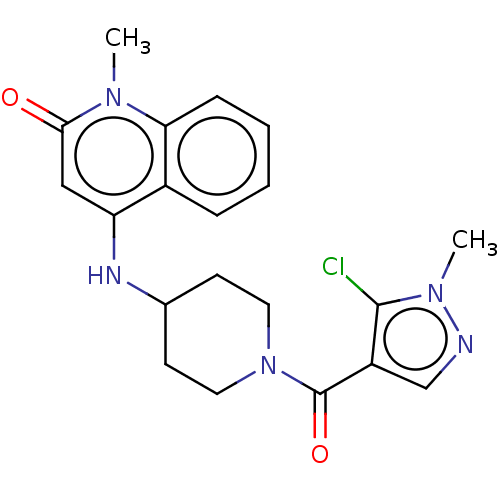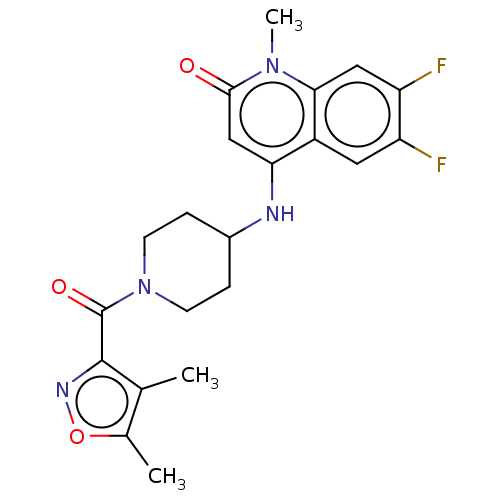Affinity DataIC50: 8.00E+3nMAssay Description:Inhibition of adenosine A1 receptor (unknown origin)More data for this Ligand-Target Pair
Affinity DataIC50: 8.00E+3nMAssay Description:Inhibition of adenosine A1 receptor (unknown origin)More data for this Ligand-Target Pair
Affinity DataIC50: 8.00E+3nMAssay Description:Inhibition of adenosine A1 receptor (unknown origin)More data for this Ligand-Target Pair
Affinity DataIC50: 8.00E+3nMAssay Description:Inhibition of adenosine A1 receptor (unknown origin)More data for this Ligand-Target Pair
TargetPotassium voltage-gated channel subfamily H member 2(Homo sapiens (Human))
Astrazeneca
Curated by ChEMBL
Astrazeneca
Curated by ChEMBL
Affinity DataIC50: 1.60E+4nMAssay Description:Inhibition of human ERG by medium-throughput electrophysiologyMore data for this Ligand-Target Pair
Affinity DataIC50: 2.19E+4nMAssay Description:Inhibition of mu opioid receptor (unknown origin)More data for this Ligand-Target Pair
TargetPotassium voltage-gated channel subfamily H member 2(Homo sapiens (Human))
Astrazeneca
Curated by ChEMBL
Astrazeneca
Curated by ChEMBL
Affinity DataIC50: >3.30E+4nMAssay Description:Inhibition of human ERG by medium-throughput electrophysiologyMore data for this Ligand-Target Pair
TargetPotassium voltage-gated channel subfamily H member 2(Homo sapiens (Human))
Astrazeneca
Curated by ChEMBL
Astrazeneca
Curated by ChEMBL
Affinity DataIC50: >3.30E+4nMAssay Description:Inhibition of human ERG by medium-throughput electrophysiologyMore data for this Ligand-Target Pair
TargetPotassium voltage-gated channel subfamily H member 2(Homo sapiens (Human))
Astrazeneca
Curated by ChEMBL
Astrazeneca
Curated by ChEMBL
Affinity DataIC50: >3.30E+4nMAssay Description:Inhibition of human ERG by medium-throughput electrophysiologyMore data for this Ligand-Target Pair
TargetPotassium voltage-gated channel subfamily H member 2(Homo sapiens (Human))
Astrazeneca
Curated by ChEMBL
Astrazeneca
Curated by ChEMBL
Affinity DataIC50: >3.30E+4nMAssay Description:Inhibition of human ERG by medium-throughput electrophysiologyMore data for this Ligand-Target Pair
TargetPotassium voltage-gated channel subfamily H member 2(Homo sapiens (Human))
Astrazeneca
Curated by ChEMBL
Astrazeneca
Curated by ChEMBL
Affinity DataIC50: >1.00E+5nMAssay Description:Inhibition of human ERG by medium-throughput electrophysiologyMore data for this Ligand-Target Pair
TargetPotassium voltage-gated channel subfamily H member 2(Homo sapiens (Human))
Astrazeneca
Curated by ChEMBL
Astrazeneca
Curated by ChEMBL
Affinity DataIC50: >1.00E+5nMAssay Description:Inhibition of human ERG by medium-throughput electrophysiologyMore data for this Ligand-Target Pair
TargetPotassium voltage-gated channel subfamily H member 2(Homo sapiens (Human))
Astrazeneca
Curated by ChEMBL
Astrazeneca
Curated by ChEMBL
Affinity DataIC50: >1.00E+5nMAssay Description:Inhibition of human ERG by medium-throughput electrophysiologyMore data for this Ligand-Target Pair









